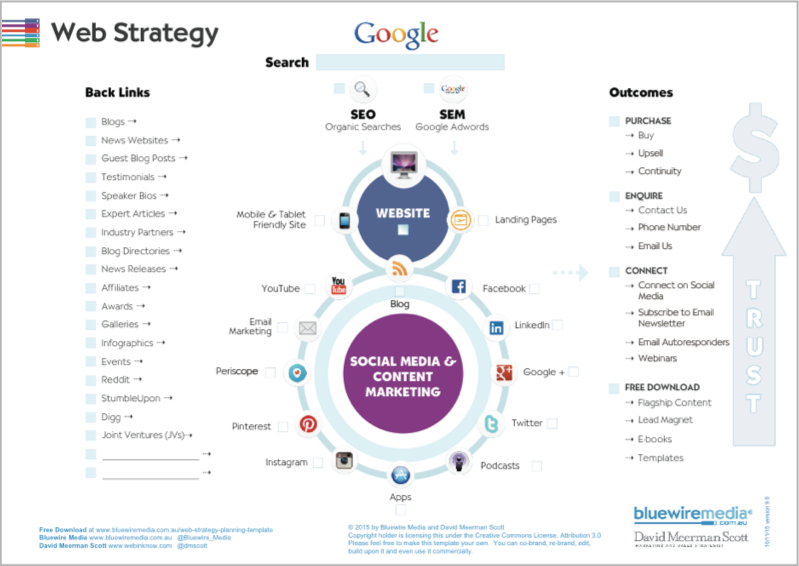How to Develop a Web Strategy From Scratch [Step-by-Step]
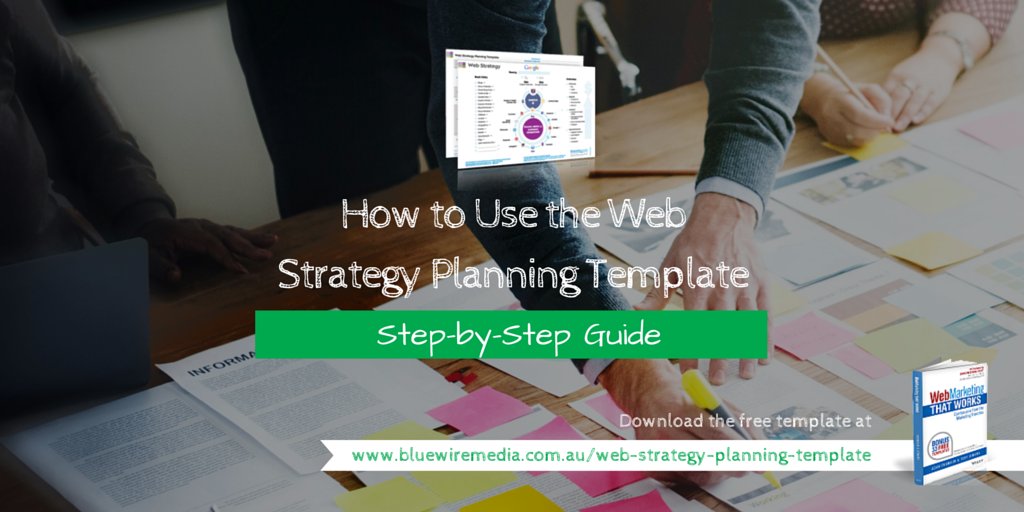
I’m sure you’ve heard about how effective web marketing can be to grow your business.
But it’s pretty confusing, right?
There is so much to learn, and so many different things to consider.
SEO, content marketing, social media marketing, paid advertising… What is going to work best for you? And perhaps more importantly, how do all these things fit together anyway? And can you fit in on a one page marketing plan?
These are the types of questions that Toby and Adam would hear time and time again from clients and event attendees all over the world, which is why they decided to create the Web Strategy Planning Template.
The Web Strategy Planning Template is our flagship piece of content here at Bluewire Media and was co-created with David Meerman Scott the best-selling author of The New Rules of Marketing and PR.
The goal of the template was to help our clients understand the building blocks of a successful web strategy and reduce the confusion that comes along with it all.
This article will step you through exactly how to create an effective web strategy from scratch using this template. If you are a consultant looking to use this template with your clients, or a small business owner just getting started with web marketing this article is for you.
The Web Strategy Planning Template has been downloaded tens of thousands of times as part of our free 33 Web Marketing Templates.
If you don’t have it already, grab a copy by clicking the link below, then come back to this post and get into it.
Table of Contents
What is a Web Strategy?
Web Strategy Planning Template Infographic
How to Use the Web Strategy Planning Template
Outcomes of Your Web Strategy
Your Website
Google
Back Links
Social Media and Content Marketing
Documenting Your Web Strategy
What Should You Do Next?
What is a Web Strategy?
A Web Strategy is like a marketing or business plan for your online presence. It’s purpose is to outline the path you want to take, the challenges you expect to see along the way, and the goals and activities that will decide where you spend your resources.
A common failure with web marketing and building a business online is to set and forget. Too often people start a website and think that that’s enough, or they don’t quite realise the commitment they are getting themselves into.
By documenting a plan for your web strategy it lays everything out in one place, helps you understand what you’re in for and prepares you for a greater chance of success and ROI.
Web Strategy Planning Template Infographic

Share This Infographic
If you’d like to embed this on your website, right click and ‘save as’ and link back to this page, or copy and paste the code below. NB. Width has been set to 100% so it will work on most layouts and adjust to the containing element.
How to Use the Web Strategy Planning Template
Business Owners, Entrepreneurs and Marketing Managers
This step-by-step training is exactly what the Bluewire team teaches in one-on-one consultations. So if you’re looking to take the next step with web marketing and grow your business online, this template will help you;
- Understand how it all works
- Document a plan to actually get results
- Kick things into gear, so you are confident you can do the things you may have been avoiding, but know are important
Digital Marketing Consultants
If you’re a digital marketing consultant, we encourage you to use the template with your clients. You can edit it, you can build upon it, you can co-brand it and use it commercially if you like, there is space for your logo in the top right-hand corner. We want you to take this template and make it your own.
It’s often easy to forget that people outside of the web marketing world don’t understand all the bits that make it come together. So use this template as a framework to educate your clients about how everything works.
Now let’s get into the step-by-step guide, starting where it all begins…
Outcomes of Your Web Strategy
What are you trying to achieve with your web marketing strategy?
The answer to this question is most likely to get more customers, grow your business or increase revenue, and defining an end goal or destination is an essential part of the process.
So if the name of the game is to eventually get people to purchase something from you, what steps do they typically need to take to get there?
All of this is covered on the right hand side of the Web Strategy Planning Template.
Each step in the outcome process increases trust with your prospects and improves the chance that they will become a customer.
You are trying to take people on a journey from stranger all the way to customer on your website, by building incremental levels of trust over time.
This journey starts with a free download…
Free Download
We refer to the free download as flagship content, but you may have heard it called a lead magnet…
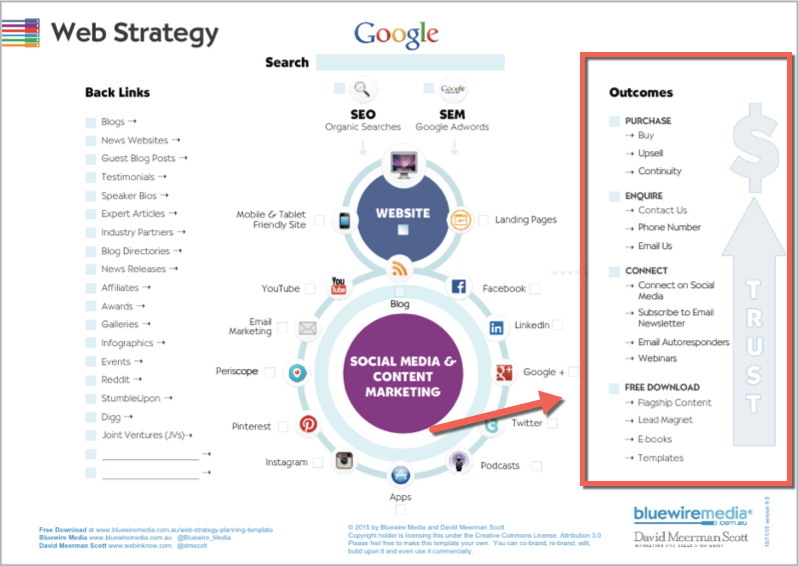
You are looking to deliver a valuable, helpful and useful piece of content that people are prepared to part ways with their email address to receive.
If you’re not sure what type of lead magnet to create as your flagship content, here’s a quick list of options to spark some inspiration;
- Template
- eBook
- Guide
- Cheat Sheet
- Checklist
- Spreadsheet
- Step-by-Step Process
- Coupon
- Discount
- Video series
- Free trial or product teaser
- Sample or giveaway
- Free software tool
- Restricted access to content
- Event or Webinar
Of course, it really comes down to how USEFUL your lead magnet is for your ideal customer. So think about their needs when creating it. On the second page of the Web Strategy Planning Template is some space for defining your ideal customer, I will talk about this later in the article.
Connect
Once someone has downloaded one of your lead magnets, now it is time to get them to know like and trust you by connecting.
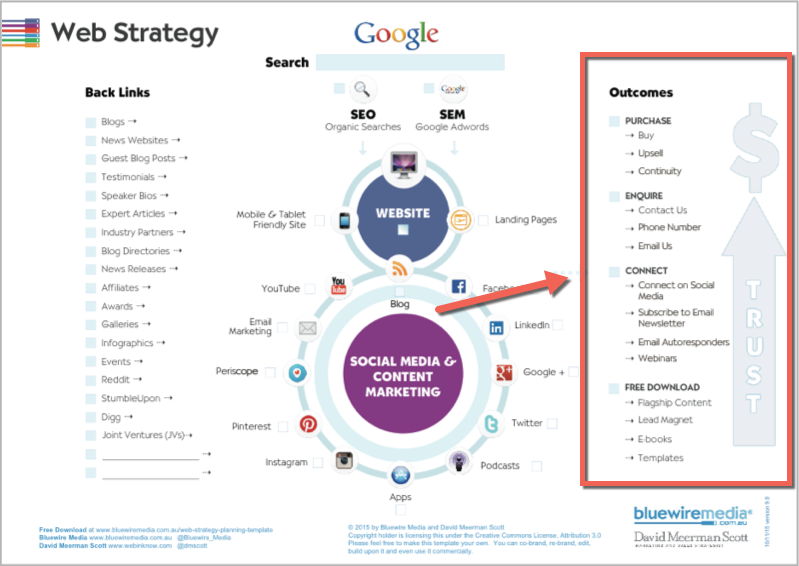
“Connecting” can come in many different forms, but here are some tips for taking your relationship to the next level with a prospective customer;
- Spark a conversation on social media
- Share their content on social media
- Leave meaningful comments on their blog posts
- Quickly respond to their questions and offer a solution
- Connect them with other valuable people
- Shine the light on your customers and show them off to the world
- Help them get to know you with personalised stories and anecdotes in an email newsletter
This connection step is extremely important when trying to build trust and encourage someone to move up the right hand side of the customer journey on this template.
Enquire
Before people are comfortable buying from you, they need to enquire first…

Once you have built up enough trust and credibility with your prospects, the next step is to make it super-easy for them to enquire with you. The easiest way to do so is through the “Contact Us” page on your website.
So what makes for a good “Contact Us” page?
It should;
- Be working – you’d be surprised how many forms are broken on these pages
- Grab the attention of your prospect and encourage them to get in touch
- Show off your personality as a company and calm a prospect’s nerves
- Be really really easy to use…. The more form fields and hurdles you place in front of a prospect the less chance you have of them following through.
Purchase
All that’s left now is for someone to purchase whatever you are selling! All that hard work and now you can cash in… But how?
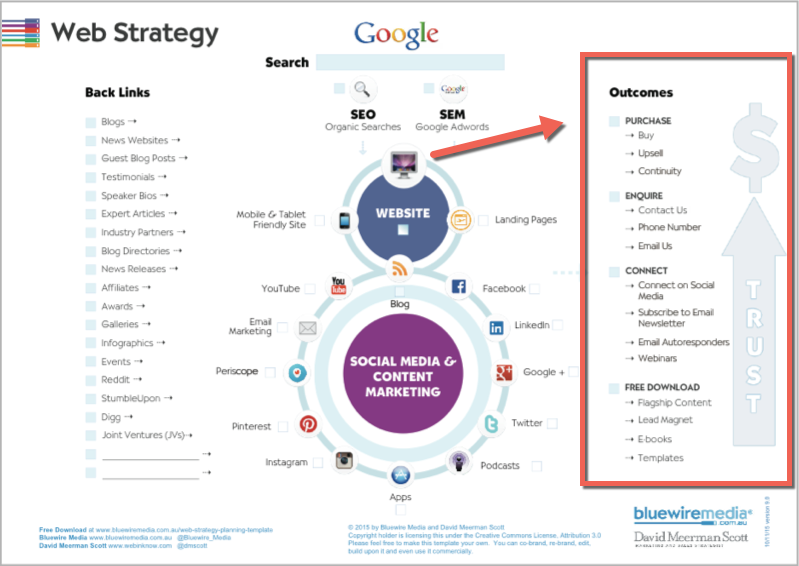
Here are some tips for optimising your website to increase sales;
- Create a unique page for every product or service with a single focus, which is to close the sale
- Use social proof such as testimonials and case studies to build trust on your product pages
- Personalise the experience with photos and images of your team or your office
- Test, test and test everything to do with the process so it is a seamless user experience
- Offer money-back guarantees or bonuses for people making a purchase
- Create scarcity with time bound deals or one-time offers
- Use an FAQ section to overcome any common objections
- Go behind-the-scenes and show a preview of what they are buying
If you have taken a prospect on the journey from free download all the way to purchasing, they are likely to become a repeat customer because your trust and credibility are already established.
Ok cool, so your outcomes are set… You’ve got each stage of the trust building customer process mapped out. But what next?
It’s all very well to have lofty goals, but now you need to put it into action.
That begins with your website…
Your Website
In the middle of the diagram sits your website. The website is at the centre of your web universe and the most important piece of the puzzle, because that’s where the commercial outcomes take place.

There are lots of different design elements, pages and techniques that contribute to an effective website. But when it comes to your web marketing strategy, there are two primary things to consider.
Creating Effective Landing Pages
A traditional definition of a landing page is essentially any page on your website that a visitor or prospect “lands” on or arrives at.
The marketing world has slowly morphed this to mean something subtly different. A landing page in marketing refers more specifically to a standalone web page that is designed with a sole focus or goal in mind, usually to get someone to buy, opt in for an email list or take some other action.
When we talk about landing pages from a marketing perspective they should be consistent with your main site in terms of branding, but not include any distracting information such as full navigation menus or sidebars. The reason for this is because you are trying to remove the options your visitors have in front of them, and encourage them to do the one thing you have optimised the page for.
Here is an example of a landing page from HubSpot that is focused on getting a prospect’s information in exchange for one of their lead magnets. (I’ll talk more about what a lead magnet is a bit later in this article)
You will see that everything someone needs to make a quick decision is in the top half of the page, and there are no other distractions.
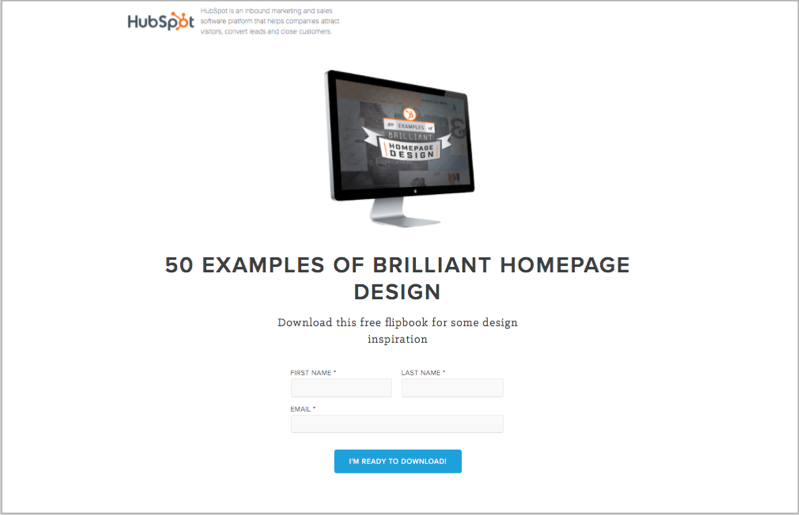
Making it Mobile and Tablet Friendly
Mobile internet devices such as smart phones and tablets are starting to take over… Mobile searches via Google have surpassed computers, desktops and laptops in 10 countries around the world. This trend is sure to continue.
In fact, Google made changes to their search algorithm (the code that decides where websites turn up in a search) to favour mobile-friendly sites, and penalise those that aren’t. So when you are building your website, or you already have one up and running, make sure it is mobile-friendly and responsive on all devices.
Hopefully you have a developer who can help you out with this, but here are some things to ask yourself;
- Does your website display properly on different devices? Use this tool to find out.
- Is it easy for users to navigate your site on a mobile device?
- Are the desired actions on your site front and centre on mobile and easy to click?
- Does your site require a “pinch-zoom” on a mobile device? (Hint: You don’t want this)
- Do all your visual media, graphics and videos perform on mobile devices?
Now, if you are clear on what you are trying to achieve with your web strategy and your website is optimised, how are you going to get people to visit it?
The first, and perhaps most common way for people to find your website is through a Google search.
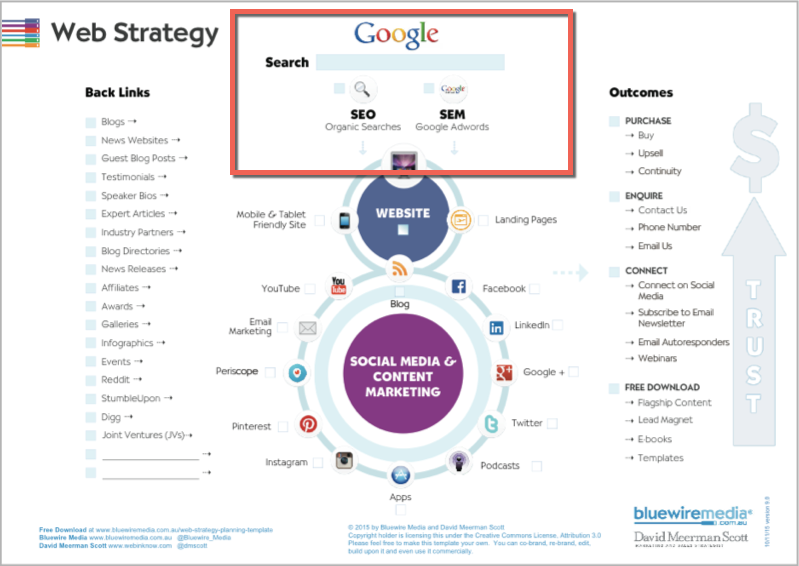
I’m sure you have used the Google search engine before by typing queries into that search box, and your ideal customers do too.
In fact, research suggests that 64% of all web traffic comes from organic search, and Google accounts for around 90% of the global search volume. That’s why it is a natural place to start.
There are two ways you can get people to visit your website from search engines;
Search Engine Optimisation (SEO)
This is all about the organic search results, the ones that show up without paying Google any money.
SEO is the process a website takes to ensure they turn up in search results for certain terms or words that their prospects search for.
The great thing about organic search results and SEO is that you are front loading the work, and ideally remaining visible a long time into the future. You are building a long term asset in the form of content that will deliver you results over time.
When it comes to “doing SEO“, there are some technical aspects that require you to optimise elements on your website, and then there are some promotional aspects that involve increasing your visibility, such as social media marketing and attracting links to your site.
If you want some more information about SEO I’d recommend reading this guide from Moz;
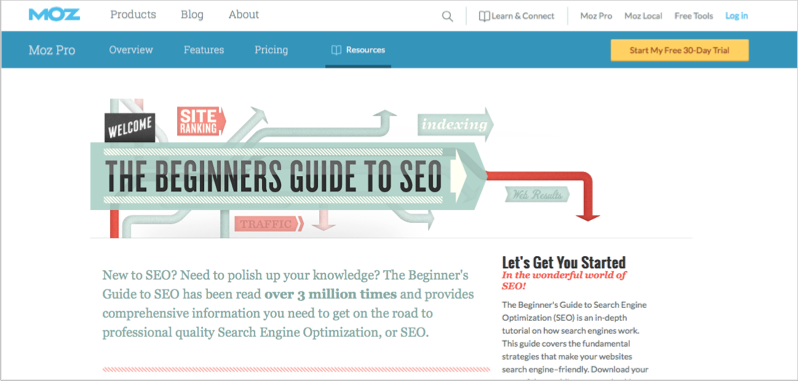
Search Engine Marketing (SEM)
The next type of traffic that comes from search engines is from Google Adwords, which is the paid search results.
SEM, as it is commonly called, refers to the process of attracting people to your website by purchasing ads on search engines.
You are “paying to play” as they say, which means it is continually getting harder and more expensive as the competition increases.
The primary problem with SEM is that as soon as you stop paying for ads, the traffic stops. Whereas with SEO and content marketing you are building an asset that will continue to deliver you traffic into the future.
However, paying for traffic can be a great way to scale up your efforts once you have all these structures in place.
The Google Adwords platform uses an “auction” system to decide what ads are displayed on a search page.
Back Links
The next way to drive traffic to your site is with back links.
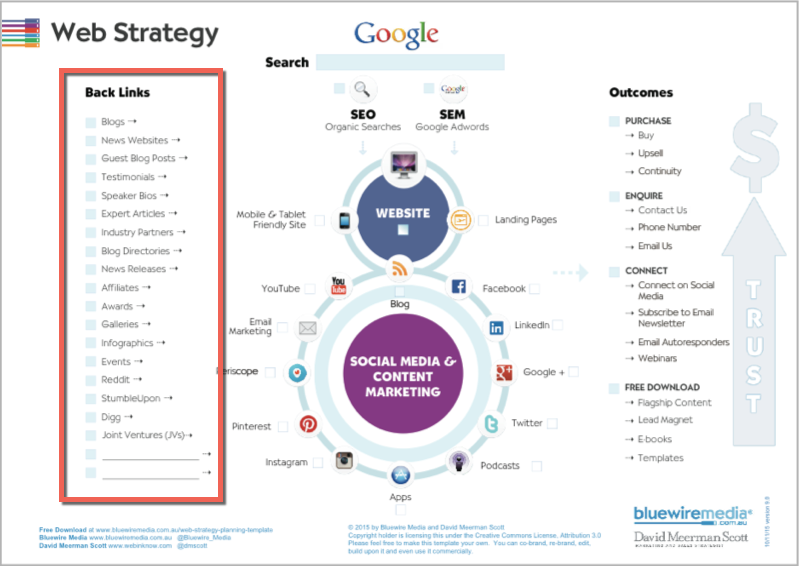
A back link is a hyperlink on somebody else’s website that when you click on it, it takes them to your website.
Like this one that is directed back to Bluewire Media from ProBlogger;
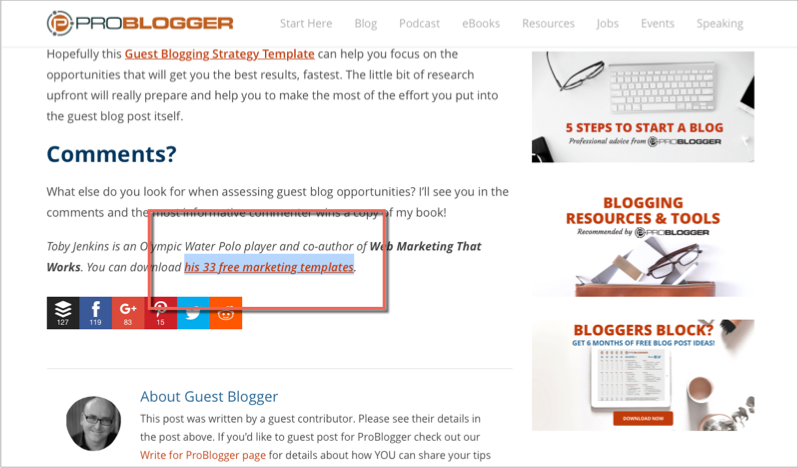
Back links are so valuable because not only do they send people to your website, they are also a vote of confidence that your website is worth seeing. Not surprisingly, back links play a big part in where your content ranks in a Google search because they are considered a quality signal by Google.
Essentially, another website is saying… “Hey, you should leave my site and go and see this other site. That’s how awesome I think it is.”
These back links can come from a variety of sources, but here is a few of them;
- Blogs
- News article
- Guest blog posts
- Testimonials
- Speaker bios
- Expert articles
- Industry partners
- Blog directories
- Press releases
- Affiliates
- Awards
- Galleries
- Infographics
- Events
- Joint ventures
Something to consider is that not all links are considered equal. Google has a complex ranking system for websites that tells it how credible or important each site on the internet is. The higher the ranking of a site, the more valuable a back link is.
Social Media and Content Marketing
Another way for people to find your website is through social media and content marketing.
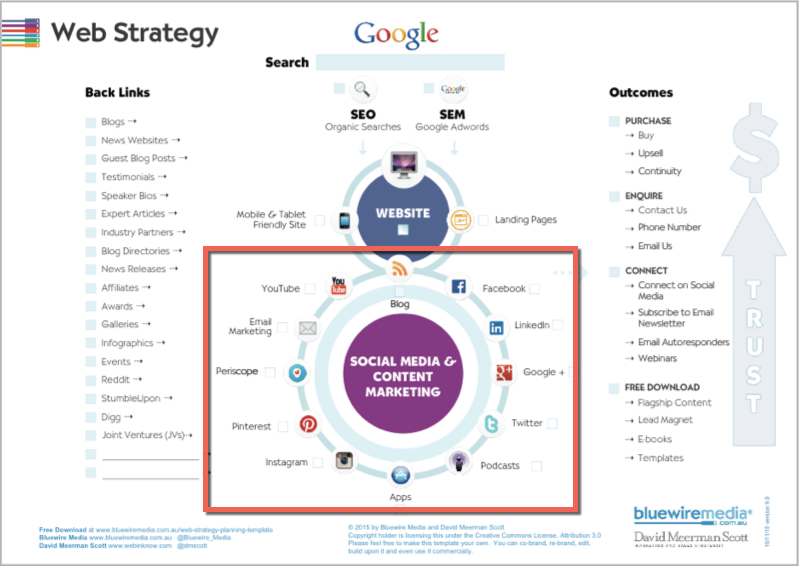
This is where you have all the social media platforms such as Facebook, Twitter, Instagram, LinkedIn and YouTube… But what ties all of these things back to your website is your blog.
Typically you are publishing content on your blog and promoting or sharing it through social media platforms.
When people share your content on social media it ripples through the social networks and more people see it.
Once they visit your website, hopefully they start the trust building process by downloading something, connecting, and eventually enquiring and becoming a customer.
Let’s have a brief look content marketing and social media marketing separately.
Content Marketing
At the core of content marketing is being helpful. It’s not about “selling” your products or services, but more about educating your prospects on how to overcome problems or achieve their goals. Of course in the end, your product or service will help alleviate these exact problems, or fast track their way to those goals.
It’s easy to get overwhelmed with content marketing and feel like you need to be doing all of it, all of the time. But it’s much more effective and achievable to focus in on one or two types of content and do them really well time and time again.
Here is a short list of the types of content you could be creating for your prospects to attract them to your website;
- Blog posts
- Podcasts
- Videos
- Webinars
- Presentations or slide decks shared via SlideShare
- Infographics and other visual media
Just creating content isn’t enough, you need to proactively engage and share your content on social media to attract an audience to your website.
Social Media Marketing
Social media marketing is more than just promotion… It’s about customer service, engagement, watching your competitors, avoiding disasters, dealing with emergencies, and being a leader of thought in your industry.
But when it comes to attracting people to the content on your website, it plays a crucial role. It is a channel for you to connect with influential people, encourage others to read your content and share the best and most up to date information available.
The more credibility you build on social media for your brand, the more effective your efforts will be when you share your latest blog post or podcast.
To document a full-blown social media plan, check out our step-by-step guide on how to use the social media planning template.
Documenting Your Web Strategy
So far this article has been somewhat theoretical… Now it’s time for you to start actually documenting how you will take action on all of this cool new information.
On the second page of the Web Strategy Planning Template you will see a set of questions and some space for you to fill in your answers.
Who
The first section to look at is the “Who”, exactly who do you want to buy from you?
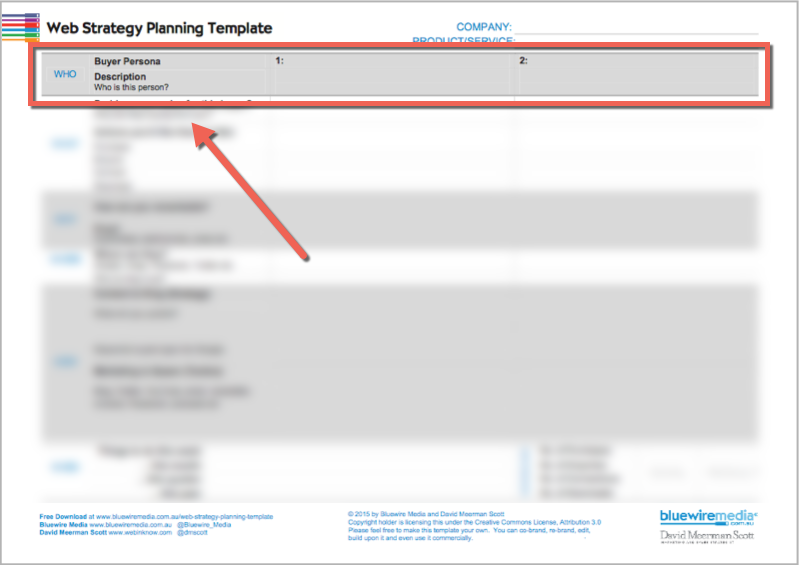
The type of information you will record in this top section is;
- Personal demographics
- Job title
- Industry
- Company size and type
- Education background
- Career path
Locking down these characteristics for your ideal customer can be challenging, but it’s a necessary evil. Because the more you know about the type of person you want to work with, the easier it is to market to them effectively.
What
What problems do you solve for this person? And what actions do you want them to take in order to do so?
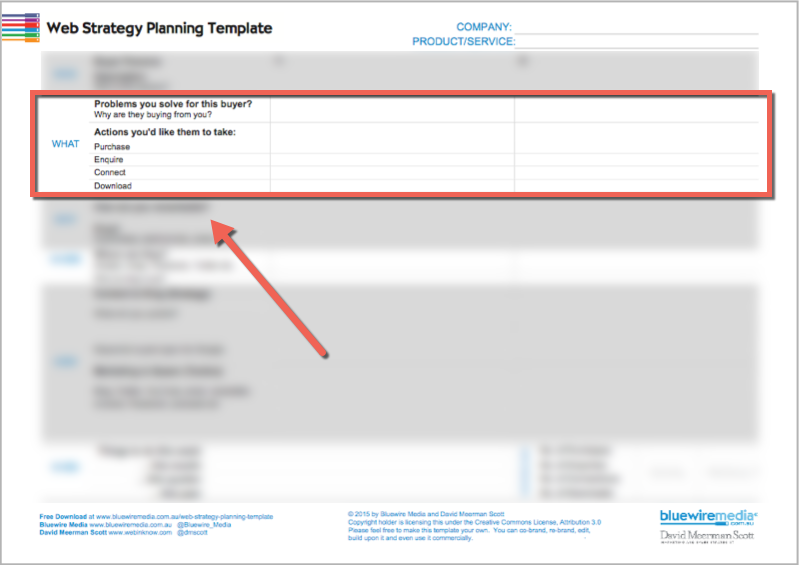
Try to get below the surface in this section and understand the common daily problems your ideal customers face. Document these problems from the perspective of your customer, putting yourself in their shoes.
Then, jot down the key elements of that trust building process we discussed earlier, for this persona specifically.
What content will you create to attract this person to your website? What free download will you give to them? How can you connect with them on a deeper level? Where can you connect with them? When they’re ready, how would they like to enquire with you? What product or service is the best fit for them?
Why
Why should this person buy from you and not your competitors? What makes you unique and remarkable?
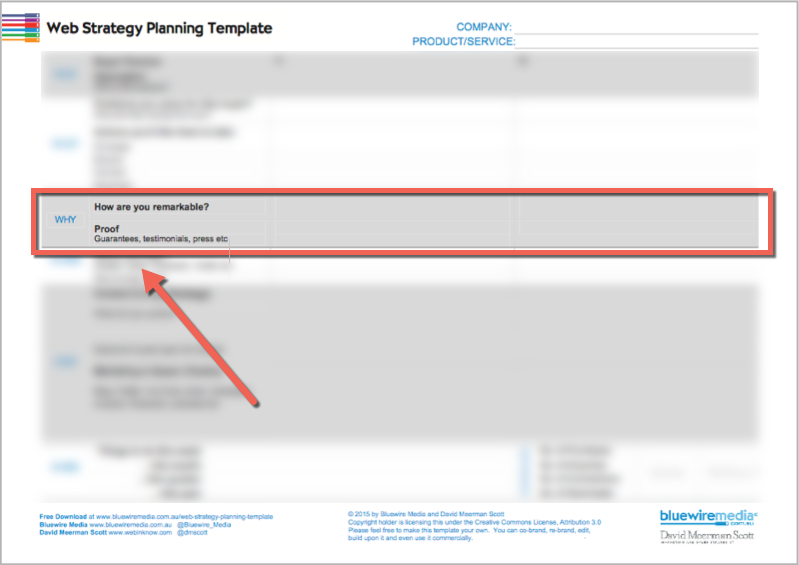
As well as documenting your unique selling proposition in this section, think about how you could prove that to your prospects using social proof.
Here are some examples of social proof you can use on your website to boost credibility and build trust with your prospects;
- Testimonials
- Case studies
- Social sharing numbers
- Embedded social media posts that reflect positively on your business
- Seals of approval and guarantees
- Reviews and ratings
Where
Where do your ideal customers hang out online?
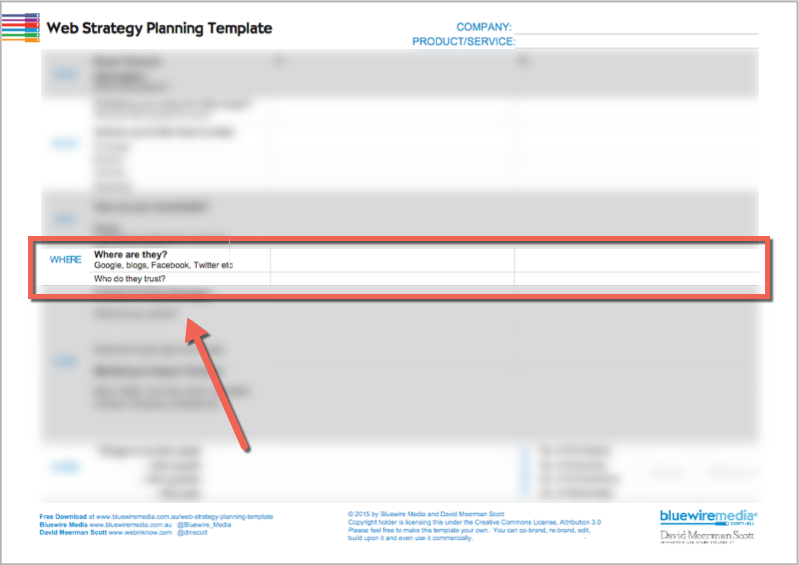
This part of the template is an often overlooked, but very important step in the web strategy process.
For all of this to fall into place, you need to know where your customers are frequently hanging out online so you can be there too.
What news sites do they trust and read every day? Which bloggers or experts do they respect? Which social networks are their favourites? Are there forums they frequent?
All of these questions will help you understand “Where” you need to focus your marketing efforts.
How
If you know who your ideal customer is, what you can offer them, why they should care and where you can find them… Then it’s just about how you will take action.
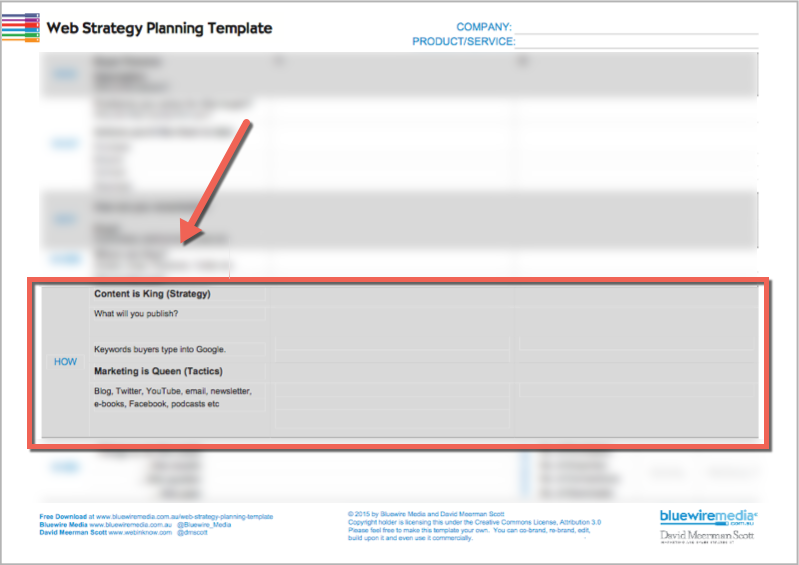
This is where all the strategies I discussed from the first page of the template come into play.
What terms are your customers likely to type into a Google search? Do you have an SEO strategy to make sure you are ranking in those searches?
How about back links… Out of the options available, how will you attract back links to your site?
What content will you create; blogs, podcasts, videos? How will you get people to see that content? What social networks will you share it on?
Who will do all of this stuff? Who’s accountable?
When
The final piece of the puzzle is deciding when all of this will happen, and how you will track success.
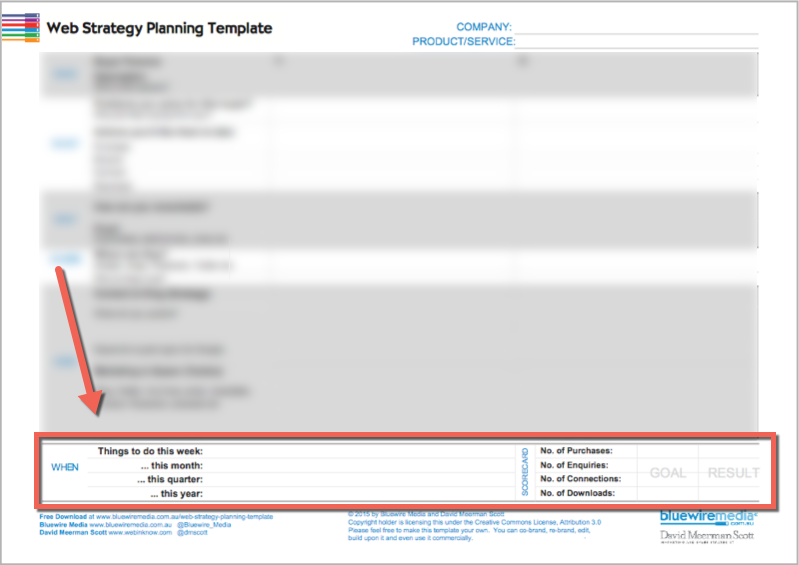
This is where everything else you’ve learnt and documented comes together. Write down your goals, and the actions you or anyone else in your organisation will take to make this web strategy happen.
What Should You Do Next?
I’m sure that was a lot to take in, so have a breather for a moment.
If you haven’t already, download the “Web Strategy Planning Template” so you can start piecing this all together.
Delivering the outcomes you are looking for with your web strategy is hard work. It takes time, persistence and most likely a few mistakes and failures.
But this template will help you shortcut the learning process and minimise those mistakes.
It might seem elementary or basic in parts, but that’s why it is so effective. Most businesses gloss over the basics which is why they don’t get a good ROI from their web marketing.
If you take the time to document your web strategy, and map out the customer journey from start to finish, you’ll be surprised and delighted at how fruitful online marketing can be.
MARKETING METHODOLOGY
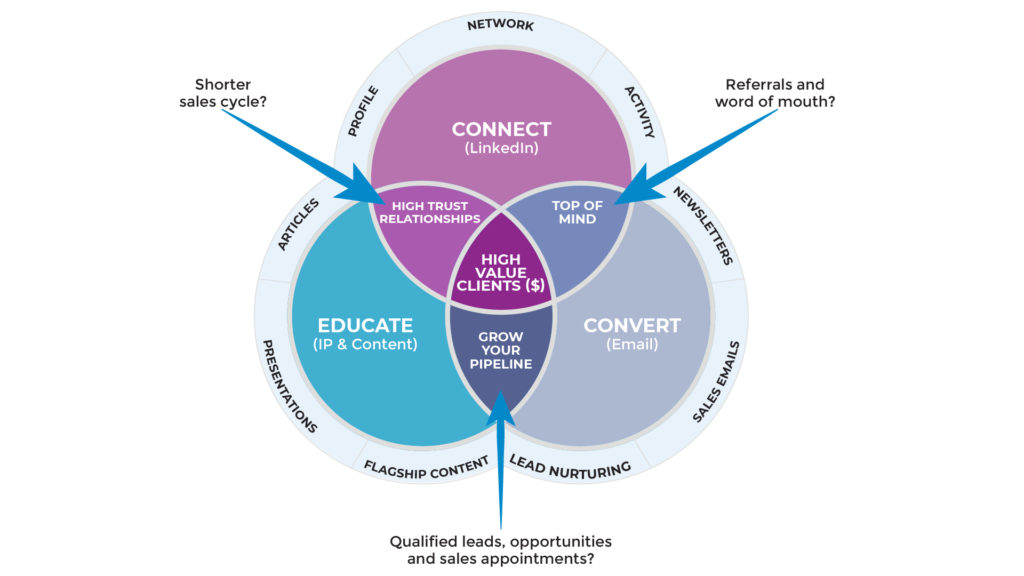
PS. When you're ready, here are 6 ways we help consultants & advisors grow:
1. Web Strategy Planning Template (PDF). Our flagship 1-page tool we co-created with David Meerman Scott. It’s been downloaded over 1 million times and featured on Forbes.
2. Read a free chapter from our book. Web Marketing That Works --- an Amazon #1 best seller.
3. Join the private group on Facebook. Access free training resources, and hang out with 2,300+ peers.
4. Discover your marketing score. Take the 40 point Marketing Scorecard (in < 6mins) and get a customised report.
5. DIY with the 50+ Script Library. It's for connecting with new people and nurturing them into high-value clients.
6. Let's brainstorm how to fill your marketing funnel. DM the word "INTERESTED" via Messenger or book a 20 min slot to talk on Zoom.Content Marketing Sales Funnel
Your content marketing sales funnel is all about getting people to know, like and trust you by nurturing them with the right information at the right time.

